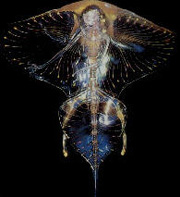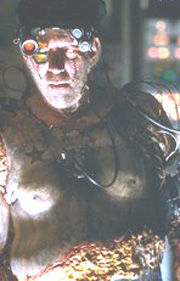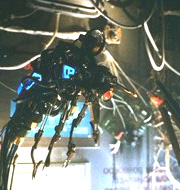Earthbased Species

Graboids
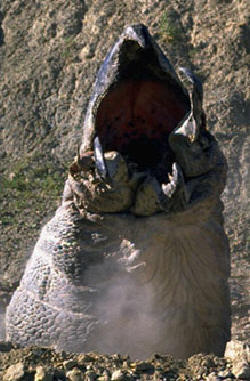
Rarely seen, these ancient creatures are believed to predate the fossil record, being from around the Pre Cambrian era, making them billions of years old. It is unknown whether this species is indigenous to earth or whether they originate from an extra terrestrial origin, possibly being carried to earth as spores or bacteria (with the potential for evolution) on an asteroid or meteorite. Graboids are a subterranean species of giant worm, spending most of their lives underground, breaking the surface only to feed. At 30 feet long, with a diameter of 5 feet at their widest point, Graboids are deadly predators. Like most other earth based subterranean species, Graboids do not possess eyes, instead sensing and tracking prey by the seismic vibrations that they produce when they move around or communicate. Like normal earth worms, Graboids are streamlined in shape and move in part by bracing themselves and pushing themselves along with stiff backward facing spikes (hairs in the case of the earthworm). These small spikes protrude from the creatures' thick leathery skin and allow it to move very quickly through the Pleistocene alluvial soil, or loose dirt. They can not, however, travel through thicker material such as rock.
Graboids are carnivorous and will eat almost any living animal, including humans. Graboids are very strong and will drag their victims underground to eat them. They are even capable of pulling whole cars underground to get at their prey inside. A Graboids mouth is beaked, helping it to break through the soil, with a complete upper section, and three sections, or mandibles, to the lower jaw. Within the Graboids mouth are three tentacles or tongues. Each tongue can move independently of the others and ends in a mouth, complete with sharp teeth and small horns. These are used to grab prey and drag them underground or into the creatures' mouth. Graboids are an intelligent, if slow, species, capable of formulating plans and thinking ahead. They have been known to dig traps under roads in order to ensnare large prey, and will undermine buildings and foundations in order to get at prey that might be sheltering on the roof. Graboids are also very patient creatures and once prey has been detected, if it manages to escape to a higher location, the Graboid will wait until it comes down. They can wait days, sometimes until their prey has died of starvation or dehydration.
Though deadly due to their ability to surprise their prey, Graboids can be detected. The disturbance they create as they move through the ground can be detected by a seismograph, and animals can sense their presence. It is also possible to detect a Graboid moving by the disturbance to the top layer of soil that it creates when it travels near the surface. Like a butterfly, the Graboid will sometimes undergo metamorphosis at a certain stage in its lifecycle. At this time it will burrow up and break the surface of the earth. After a period of hours, in which the Graboid will apparently undergo considerable pain and stress, it will burst, giving "birth" to three new creatures, each one coming from an egg pod within the Graboid's body. These are Shriekers. For further information on the Graboid species, including external and internal anatomy, ecology, evolution and hypothetical taxonomy, refer to the US Department Of The Interior "Scientific Analysis of the Graboid".
Read more about xenomorphic species.
Shriekers
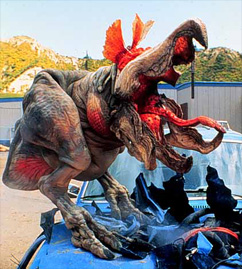
After a period of metabolic change and metamorphosis, a Graboid will burst, giving "birth" to three Shriekers - each developing in an egg pod within the Graboid's body. A Shrieker is vaguely similar to a Graboid in some of its physical appearance, but it's physiology is very different. A Shrieker is a bipedal creature approximately 3 1/2 feet high and 5 feet long. It retains the mouth parts of the original Graboid, but each Shrieker only has one tongue, rather than the Graboid's three. This tongue is used to sweep areas, searching for food. If it touches anything that it considers to taste good, it will eat it.
Like the original Graboid, a Shrieker does not possess eyes. However, instead of sensing prey, and the world around it, by seismic vibrations (as the Graboid did), Shriekers sense using infrared. Located on top of the head are flaps of skin that will lift like frills, exposing a heat sensitive organ which can sense the body heat given off by any living thing, or anything, living or non-living, which gives off heat. This means that as well as attacking living creatures, Shriekers are also known to attack such hot objects as engines and radio equipment. As Shriekers can not see (non-hot objects) or hear, they communicate with each other using a very specialised Shriek (hence the name Shriekers). The noise that is made when a Shrieker shrieks is irrelevant, what is important is that when it shrieks a Shrieker releases a great deal of heat. This form of communication alerts other Shriekers to potential prey or danger. Although as unknown at this time, it may be possible for a Shrieker to alter this heat signal, allowing it to communicate different things using a form of basic heat signal language.
Shriekers are hermaphrodites. This means that they do not reproduce by sexual means. Once a Shrieker has consumed an adequate mass of food it will regurgitate an infant Shrieker. This allows Shriekers to reproduce at an almost geometric rate. It is unknown at this time whether Graboids are also hermaphrodites, or if it is only the smaller Shriekers which possess this trait. Following a period of 24 to 72 hours after birth, a Shrieker will undergo metamorphosis, changing into the (possibly) final stage of the Graboid lifecycle; the AssBlaster. For further information on the Graboid species, including external and internal anatomy, ecology, evolution and hypothetical taxonomy, refer to the US Department Of The Interior "Scientific Analysis of the Graboid".


